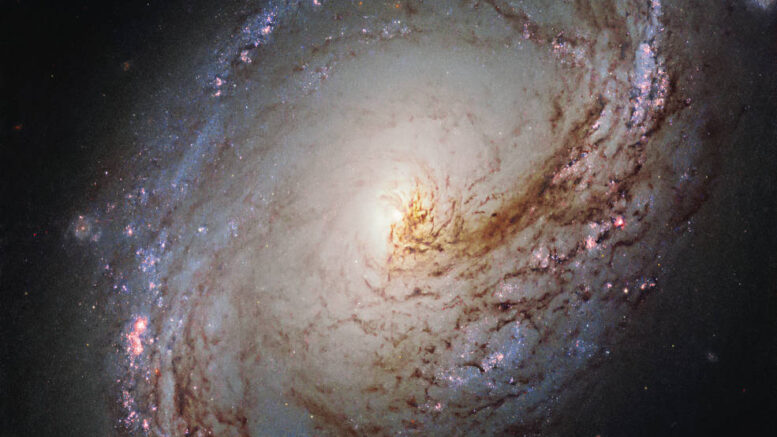Messier 96 is an intermediate spiral galaxy located in the constellation Leo. Messier 96 is a double-barred spiral galaxy with a small inner bulge through the central region along with an outer bulge. The galaxy is estimated to contain about 100 billion stars. The nucleus of M96 shows a weak level of activity of the LINER2 (low ionization nuclear emission region) type. The galaxy’s bright inner disk is home to a yellow population of old stars, while the spiral arms have rings of blue knots which are open clusters of young, hot, blue stars.
There is a supermassive black hole in the nucleus of M96.
| Description | |
| Visible From Pacific Northwest | January To May |
| Best Time To Observe | April |
| Minimum Size Of Viewing Device | Small Telescope |
| Object Type | Intermediate Spiral Galaxy |
| Designations | Messier 96, M96, NGC 3368, PGC 32192, ALFALFA 5-321, TC 532, UGC 5882, Z 66-13, Z 1044.1+1205, EQ 1044+120, IRAS 10441+1205, 2MASX J10464574+1149117, MCG+02-28-006, SDSS J104645.67+114911.8 |
| Right Ascension | 10h 46m 45.7s |
| Declination | 10h 46m 45.7s |
| Constellation | Leo |
| Number Of Stars | 100,000,000,000 (100 billion) |
| Apparent magnitude | +10.1 |
| Apparent dimensions | 7′.6 x 5′.2 |
| Object Radius | 50,000 light years |
| Distance From Earth | 31,000,000 light years |
History
Messier 96 was discovered by Charles Messier’s friend and colleague Pierre Méchain on March 20, 1781, along with the neighbouring Messier 95. Méchain reported the discovery to Messier, who added both objects to his catalogue four days later, on March 24, 1781.
John Herschel catalogued M96 as h 749 and later included it in the General Catalogue as GC 2194. He described the object as “very bright; very large; little extended; very suddenly very much brighter toward the middle; mottled.”
Messier 96 is one of the first galaxies to have its spiral structure recognized. William Parsons, 3rd Earl of Rosse, included it on his list of 14 “spiral nebulae” discovered to 1850.
Locating M96 In The Sky
Messier 96 can be found along the line from the bright star Regulus to the slightly fainter Denebola. The place where this line intersects with a line drawn between the stars Chertan and ρ Leonis, is roughly in the same field of view as M96. The galaxy can also be located using the 5.3 magnitude star 53 Leonis, which is less than 2 degrees away from M96.

Viewing M96
The best time of year to observe the galaxy is during the spring. The galaxy requires good conditions, with clear, dark skies, and is very difficult to see with binoculars. In large binoculars, it only appears as a very faint patch of light. Small telescopes reveal the galaxy’s oval core, while 8-inch telescopes show some of the details of the galaxy’s structure. 10-inch telescopes reveal a halo extending across an area 3 by 5 arc minutes in size and a brighter centre.
Photographing M96
Because of their small size and great amount of detail, each galaxy is best photographed with a large telescope, such as 12” or bigger. If using an 8” telescope or smaller, like us, you can center the view right in between M96 and M95. By doing so, you will be able to capture several galaxies from the M96 Group.
Processing can be a little tricky in a sense that you need to keep an eye on each of those worlds, and keep their brightness, saturation, and crispness similar to each other.
Sources And Further Reading
Descriptions of all of Messier Objects can be found here.
https://www.messier.seds.org/m/m096.html
https://www.galactic-hunter.com/post/m96-group-8-galaxies-in-the-constellation-of-leo

Be the first to comment on "Messier 96"